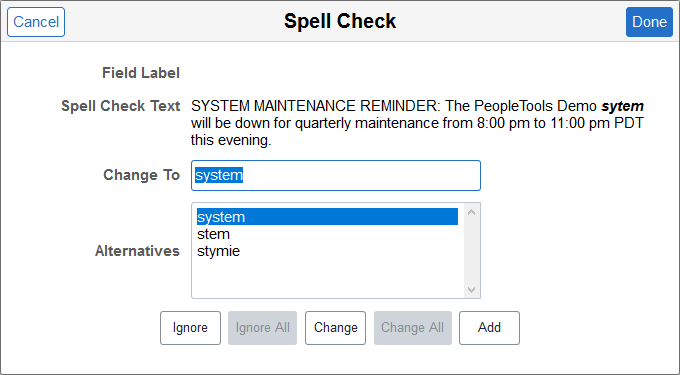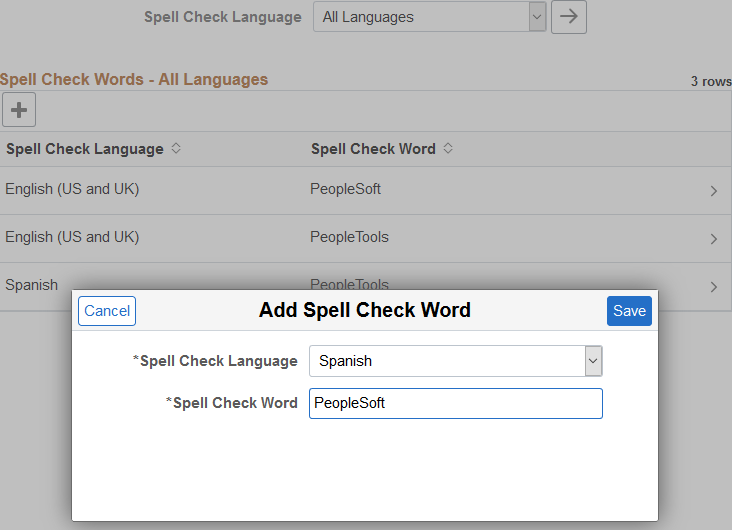Using Spell Check
PeopleSoft applications are equipped with a spell check feature that you can use for data entered in edit boxes and long edit boxes. Activate spell check by clicking the spell check button next to those fields where spell check is available.
Note: On classic components where the Spell Check tool bar button is enabled, you can click Spell Check.
|
Field or Control |
Definition |
|---|---|
 |
Click to activate spell check for the corresponding field. If no spelling errors are found, you will see the message “No misspellings found.” You can also activate spell check by pressing Alt+5 when the cursor is in the field. |
 |
Note: The Spell Check tool bar button is supported on classic components only. Click the Spell Check tool bar button to activate spell check for all fields in the component that have been enabled for spell check, regardless of whether those fields have changed. The system checks each field and then proceeds to the next spell check field until all fields in the component have been checked. If no errors are found, the "No misspellings found" message will appear. |
Running a spell check opens the Spell Check page. This page displays the errors in the text and offers a list of alternatives, if applicable. You can ignore the occurrence, ignore all occurrences, change the spelling, change the spelling for all occurrences, or add the word to the current language dictionary.
Image: Spell Check page
This example illustrates the fields and controls on the Spell Check page. You can find definitions for the fields and controls later on this page.

|
Field or Control |
Definition |
|---|---|
| Field Label |
Displays the field label text of the field currently being checked. |
| Spell Check Text |
Displays all of the text in the field being checked, highlighting the first misspelled word. This field is display-only. This field information is particularly important when multiple fields are being checked simultaneously by using the toolbar action or mandatory spell check. |
| Change To |
Initially displays the first highlighted value in the Alternatives list. You can select a new value from the Alternatives list or enter a new word in the Change To field. The maximum length is based on the maximum field length, which is 40 characters. If you enter a new value, the system spell checks the entry when you click the Change or Change All buttons to verify the correct spelling. If the system does not find any alternative spellings, the Change To field is blank and the Change and Change All buttons are disabled. |
| Alternatives |
Lists other possible spellings. The options listed match the case of the misspelled word. |
| Ignore |
Click to leave the current spelling as is and locate the next misspelled word. |
| Ignore All |
Click to leave the current spelling as is for all text in the field that exactly matches the original text. This action is case-sensitive; only exact matches are ignored. |
| Change |
Click to correct the error to the value that appears in the Change To field. Users can either select one of the proposed alternatives or type in their own value. The system then moves to the next misspelled word. |
| Change All |
Click to correct all occurrences of the error with the value in the Change To field. You can either select one of the proposed alternatives or type in your own value. The system then moves to the next misspelled word. Like Ignore All, this action is case-sensitive; only exact matches are changed. |
| Add |
Click to add the highlighted misspelled word (as is) to your currently selected personal dictionary. The system then moves to the next misspelled word. Additions to the dictionary must be 40 characters or less. See Selecting a Spell Check Dictionary and Using the My Dictionary Page. |
Mandatory Spell Check
Note: Mandatory spell check can be enabled on classic components only.
Certain pages, such as those that require an email response, have a mandatory spell check requirement. When you save these pages, the system automatically runs spell check on spell check enabled fields. A field is eligible for automatic spell check if you have changed its contents and you have not already run spell check for that field. If a page has more than one spell check field, spell check runs in succession. If no errors are found, the system saves the data without issuing a message.
Spell check supports numerous languages. Your current spell check dictionary is based on your setting in My Preferences.
To change your spell check dictionary:
Select My Preferences from the Actions menu.
Note: Alternatively, My Preferences is also available at the root of the Navigator menu.
Expand the General Options section if it isn’t already expanded.
Select a value for the Spell Check Dictionary.
Note: The default value, Use session language, uses the dictionary associated with your signon language as specified on the Manage Installed Languages page.
Click Save.
Note: You do not need to sign out and sign in again for this change to take effect. Therefore, you can change the spell check language multiple times within the same signon session.
Note: Hyphenation for Hungarian is not currently supported.
Use the My Dictionary page to maintain a personal dictionary of spell check words by language.
Navigation
Image: My Dictionary page
This example illustrates the fields and controls on the My Dictionary page. You can find definitions for these options in this section.

As you use spell check, you might need to add certain words or acronyms to your personal dictionary so that spell check does not continually attempt to correct them. You can add these words by clicking the Add button while you are spell checking or you can add several at once by using the My Dictionary page. This page enables you to add, update, and delete words by language. The words that you enter in your personal dictionary are attached to your user ID, so your personal dictionary is available to you no matter where you access it.
Note: The maximum number of words in the personal dictionary is 2882.
|
Field or Control |
Definition |
|---|---|
| Spell Check Language |
Select the language to display in the grid. Note: Select All Languages to display all of the entries in your personal dictionary. |
 |
Click the Apply Language button to update the grid based on the currently selected language. |
 (or Add Word) (or Add Word) |
Click the Add Word button to add a new word to your spell check dictionary. Note: When the grid is empty, the Add Word button appears with those words as a label, and not as a + sign. |
Spell Check Words - Selected Language
|
Field or Control |
Definition |
|---|---|
| Spell Check Language |
The spell check language selected for this word. |
| Spell Check Word |
The word entered in your dictionary. Click the row in the grid to update the entry. You can change the spell check language, change the word, or delete the entry entirely. |
Add Spell Check Word Page
|
Field or Control |
Definition |
|---|---|
| Spell Check Language |
Select the language to which you want to add the word. To enter the same word in multiple languages, make a separate entry for each language. After saving a new word, the page and grid are refreshed to show only words entered in this selected language. Important! Do not select Use session language in the current release. |
| Spell Check Word |
Enter the word or abbreviation that you want added to your personal dictionary. Entries must be 40 characters or less. |
The words that you add to your personal dictionary are case sensitive. The case determines how spell check validates correct spelling. The system applies the following case-sensitive rules:
If the added word is all lowercase, such as worklist, then the following rules are valid:
Exact match, all lowercase (worklist).
All uppercase (WORKLIST).
Initial capitals (Worklist), regardless of the position of the word in the sentence.
Mixed case (WorkList) is incorrect.
If the added word is all uppercase, such as CRM, then only an exact match is valid. Lowercase and mixed case are not valid.
If the added word is in initial capitals, such as California, then only an exact match (California) and all uppercase (CALIFORNIA) are valid.
If the added word contains an embedded capital letter, such as PeopleSoft, then only an exact match is valid.
If case is not relevant to the validity of the word, then enter the word into your dictionary in all lowercase.